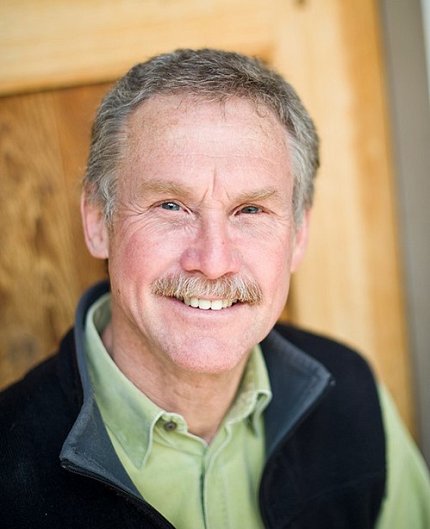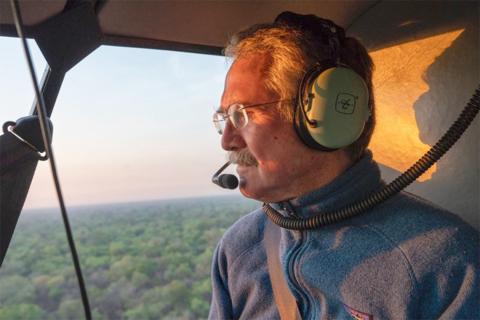Quammen Visits RML
Author Imparts Writing Wisdom

“This could be it,” David Quammen warned readers in a New York Times op-ed in early January 2020. The “it” in question was a new viral coronavirus (thought to have been transmitted from bats) that was spreading rapidly in China. Quammen had predicted this chain of events in his 2012 book Spillover, which chronicled his travels interviewing researchers and learning about pathogens that could be transmitted between animals and humans (called zoonotic diseases).
In 2020, Quammen began work on a new book solely about Covid. The resulting work, Breathless, was released in late 2022. Quammen recently stopped by NIAID’s Rocky Mountain Laboratories campus to talk about researching this latest book, and to impart some of his best advice about science writing.
Quammen began his writing career as a journalist. He studied the author William Faulkner in graduate school and wrote several novels early on, but Quammen found himself drawn to scientific topics such as ecology and evolutionary biology for his journalistic “beat.”

Photo: Charlie Hamilton James
His interest in zoonotic diseases began when he was reporting on Ebola virus for National Geographic. The story of that virus, plus other zoonoses around the world, became Spillover. The book was well-received by readers and reviewers, Quammen said, but many people were skeptical that a zoonotic disease could pose as large a threat as he was warning.
Then, Covid-19 came along. His agent quickly asked him to write a book on the pandemic and Quammen agreed “after about 5 seconds [of deliberation].” To him, it almost felt like a “duty” because of his experience writing about zoonoses.
He was faced with two significant hurdles: one, his philosophy of “go there” to research and interview scientists in-person would not work with travel restrictions, and, two, he wasn’t sure how to tackle a subject that many other people were already writing about. He didn’t have answers to those two questions until December 2020, at which point he began work on the book.

Photo: Ronan Donovan
Zoom solved his first problem; he conducted 95 interviews, including talks with big players like NIH’s Dr. Anthony Fauci and Dr. Barney Graham as well as “unknowns” (graduate students) in research labs.
To tackle the originality problem, Quammen decided to write about the Covid virus itself, SARS-CoV-2, and the scientists researching it, rather than the public health and political issues it caused. The scientists he interviewed became his “Greek chorus.” He spoke to each one for about an hour and a half, often getting up at around 4:30 or 5 a.m. to meet with researchers around the world. When he finished interviewing in June 2021, he had six months to write his book.
“I drink coffee until I go into a trance and then I write,” he joked. But, over the course of his career, he has accumulated a list of principles he uses to turn science into page-turning stories:
- The “grab.” An author needs to command a reader’s attention from the beginning. Whether it is with humor, suspense or some other device, Quammen said, he must convey to readers that his writing is worthy of their time and attention.
- Voice. “People want to hear a human voice [when they read a book].” Voice can be the way the narrator’s personality comes across on the page. “[Readers] can tell very quickly if the voice is one they want to spend hours with.”
- Story and characters. “People want to read about people,” so write about the people who do science and make sure they are fleshed-out, three-dimensional characters with a narrative arc.
- Suspense and discovery. “Science is full of mysteries—especially zoonotic diseases”—that writers can capitalize on.
- Emotion. Even in science writing there is room for emotion, typically by employing characters. Through characters and the things that happen to them, readers can experience anything from humor and joy to sadness and anger.
- Structure. Quammen’s graduate work on the structure of Faulkner novels paid off in teaching him how to structure his own books. The events shouldn’t be too easy to predict, but all of the pieces of the story should “form a whole by the end that makes sense.”
- Ending. Quammen prefers to leave some things unresolved at the endings of his books. It might surprise the reader at first, he said, but you should be asking them to keep thinking about what they’ve learned.
- Figurative language. Readers love devices such as simile and metaphor, Quammen has found, and writers can use figurative language to help readers understand scientific concepts. One common example is the “key in a lock” comparison, in which the spike protein of SARS-CoV-2 acts like a key in the “lock” of receptors on the membranes of human cells.
- Accuracy over precision. When communicating to lay audiences writers may not be able to deliver as much precision as scientists do in journal papers, but accuracy should still be conveyed in a way that is understandable.
Quammen used all of these techniques in his latest work. He wanted Breathless to deliver an important message about science itself: “That science is a human process of incremental progress…and sometimes we make mistakes.”
Low scientific literacy among the general public allows misinformation to spread more easily and decreases public confidence in the scientific process. Clear scientific communication is essential to restoring public confidence.
As a lay author who has published several acclaimed scientific titles, Quammen hinted at how he has attained a high level of scientific literacy.
“I’m not a scientist,” he said. “Just someone who listens.”
